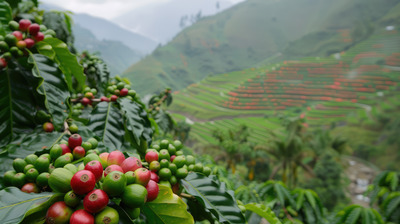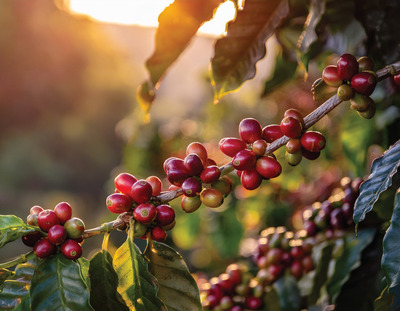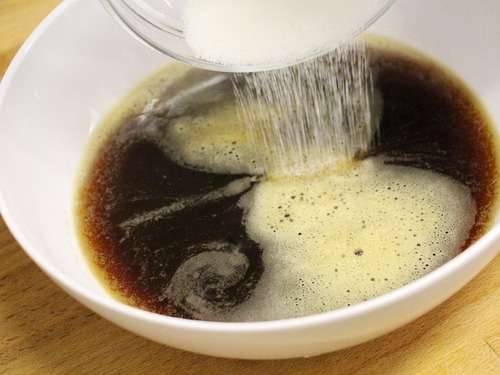The Journey of Coffee
Myths and legends surround the discovery of coffee, hinting at its profound impact on human culture. One popular tale comes from Ethiopia, where a goat herder named Kaldi reportedly noticed his goats becoming unusually energetic after eating berries from a particular tree. Curious, Kaldi tried the berries himself and felt a similar burst of energy. He then shared his finding with local monks, who began using the berries to stay alert during long prayer sessions.
Ethiopia and coffee:
- Coffee originated in Ethiopia, where the Coffea arabica plant grows wild.
- The Kaldi legend reflects its early use by monks to stay alert during prayers.
- Ethiopia remains a major coffee producer, with a strong cultural tradition centered around the coffee ceremony and regions like Sidamo and Yirgacheffe known for their high-quality beans.
Yemen and coffee:
- Yemen was the first country to cultivate and trade coffee, spreading it globally.
- The legend of Sufi mystic Omar highlights Yemen’s connection to coffee discovery.
- Yemeni coffee culture shaped the global coffeehouse tradition, with the port of Mocha becoming a key center for coffee trade.
Historical Spread
Coffee cultivation likely began in Ethiopia, where the plant grew wild in the southwestern highlands. From Ethiopia, it crossed the Red Sea to Yemen in the 15th century, and the port of Mocha became synonymous with coffee trade, giving us the term “mocha.”
Origins of Coffee: Coffee cultivation likely began in Ethiopia, where the plant grew wild in the southwestern highlands. From there, it crossed the Red Sea to Yemen in the 15th century. The port of Mocha became a key hub for the coffee trade, giving us the term “mocha” that we still use today.
Middle Eastern Coffeehouses: As coffee spread through the Middle East, it became a central part of social and intellectual life. Coffeehouses in cities like Cairo, Damascus, and Istanbul turned into hubs for conversation, political discourse, and artistic expression. These “schools of the wise” played an essential role in the exchange of knowledge and ideas.
Introduction to Europe: European travelers and merchants encountered coffee during their journeys to the East. By the 17th century, coffee had reached Europe. Venice, due to its strong trading ties with the Middle East, was among the first European cities to embrace the beverage. Coffeehouses soon spread to major cities like London, Paris, and Vienna, where they became important social and cultural centers.
Global Expansion of Coffee: The global expansion of coffee cultivation began in the 18th century when European colonial powers established plantations in tropical regions. The Dutch played a significant role by introducing coffee plants to their colonies in Indonesia and the Americas. By the 19th century, coffee had become a global commodity, with plantations flourishing across Latin America, Africa, and Asia.

Growing Regions
Coffee thrives in specific environmental conditions, primarily found in what’s known as the “Coffee Belt” or “Bean Belt.” This region, located between the Tropics of Cancer and Capricorn, offers the ideal climate for coffee cultivation: moderate temperatures, rich soil, adequate rainfall, and specific altitudes.
The Coffee Belt includes parts of Central and South America, Africa, the Middle East, and Asia. Some of the most renowned coffee-growing regions include:
- Colombia: Known for its mild, well-balanced Arabica beans.
- Brazil: The world’s largest coffee producer, offering a wide range of flavors.
- Ethiopia: The birthplace of coffee, producing distinctive, wine-like flavors.
- Kenya: Famed for its bright, acidic coffees with fruity notes.
- Indonesia: Home to unique varieties like Sumatra and Java, known for earthy, full-bodied flavors.
These regions produce the best beans due to a combination of factors. Altitude plays a crucial role; many high-quality coffees grow at elevations between 3,000 and 6,000 feet. At these heights, the cooler temperatures slow the growth of the coffee cherries, allowing more time for complex flavors to develop.
Moreover, soil composition greatly affects coffee quality. Volcanic soils, rich in minerals, often produce coffees with distinctive flavors. Additionally, the amount and timing of rainfall, as well as the balance between sun and shade, all contribute to the final taste profile of the beans.
Varieties of Coffee Plants
While over 100 species of coffee plants exist, two main varieties dominate commercial production:
- Arabica (Coffea arabica): Making up about 60-70% of global production, Arabica is prized for its smooth, complex flavors and lower caffeine content. However, it’s more challenging to grow, requiring specific altitude and climate conditions.
- Robusta (Coffea canephora): Accounting for most of the remaining 30-40% of production, Robusta has a stronger, harsher taste and higher caffeine content. It’s more resistant to disease and can grow at lower altitudes, making it easier and cheaper to produce.
Less common varieties include:
- Liberica (Coffea liberica): Native to western and central Africa, Liberica has a unique flavor profile described as woody and smoky. It represents only a tiny fraction of global production.
- Excelsa (formerly Coffea excelsa, now classified as a variety of Liberica): Known for its tart, fruity flavor, Excelsa primarily grows in Southeast Asia.
Each variety has its own genetic makeup, resulting in different flavor profiles, growing requirements, and resistance to pests and diseases. This diversity allows coffee to grow in various environments and provides a wide range of taste experiences for consumers.
From Cherry to Bean

Harvesting Methods
The journey from coffee plant to your cup begins with harvesting. There are two main methods:
- Hand-picking: This traditional method involves selectively picking only the ripe cherries. It’s labor-intensive but ensures the highest quality as pickers can distinguish between ripe and unripe fruits. This method is common in regions with uneven terrain or where labor costs are lower.
- Mechanical harvesting: Used primarily on large, flat plantations, machines shake the trees to remove cherries. This method is faster and more cost-effective but less selective, often resulting in a mix of ripe and unripe cherries.
Some regions use a combination of both methods, employing machines for the main harvest and hand-picking for subsequent passes to gather remaining ripe cherries.
Processing Techniques
After harvesting, workers must process coffee cherries quickly to prevent spoilage. There are three main processing methods, each significantly impacting the final flavor profile:
- Wet (or Washed) Process: Workers depulp the cherries mechanically, then ferment them to remove the remaining mucilage. After washing, they dry the beans. This method typically produces cleaner, brighter flavors and is common in regions with reliable water sources.
- Dry (or Natural) Process: The oldest method, where workers spread whole cherries out to dry in the sun. This process allows the cherry’s sugars to ferment, imparting fruity, complex flavors to the beans. It’s water-efficient but requires more space and careful monitoring to prevent mold.
- Honey Process: A middle ground between wet and dry processes. Workers remove the cherry’s skin, but leave some or all of the mucilage on during drying. This can result in sweeter, more full-bodied coffees. The amount of mucilage left on creates different sub-categories: white, yellow, red, or black honey process.
Each of these methods interacts differently with the inherent flavors of the coffee variety and its growing conditions. As a result, they contribute to the vast array of flavor profiles available in the world of coffee.
The Art of Coffee Making
Roasting: Unlocking the Full Potential of Coffee Beans
The roasting process is where coffee beans transform from their raw, green state into the aromatic brown beans we know and love. This crucial step significantly impacts the final flavor profile of your cup of coffee.
Roast Levels: From Light to Dark

Coffee roasts generally fall into four main categories:
- Light Roast: These beans are light brown and have no oil on the surface. They retain most of the bean’s original flavors, offering a crisp acidity, a mellow body, and often floral or fruity notes. Light roasts have the highest caffeine content.
- Medium Roast: Slightly darker than light roasts, these beans have a stronger flavor and a non-oily surface. They offer a balanced flavor, aroma, and acidity, with a brown sugar-like sweetness.
- Medium-Dark Roast: These beans have a richer, darker color with some oil on the surface. They have a heavier body compared to medium roasts, with more pronounced bitterness.
- Dark Roast: These beans are dark brown, almost black, with a shiny, oily surface. They have a pronounced bitter, smoky, or even burnt taste, with the lowest caffeine content among all roasts.
The Maillard Reaction: The Science Behind Coffee Flavors
The complex flavors in roasted coffee develop through a process known as the Maillard reaction. This chemical reaction occurs between amino acids and reducing sugars when exposed to heat. It’s responsible for the browning of the beans and the creation of hundreds of different aroma compounds.
As the beans heat up, they undergo several stages:
- Drying Phase (up to 175°C): Moisture evaporates, and the beans turn yellow.
- First Crack (around 196°C): Beans expand and make a cracking sound.
- Development Phase: Flavors develop between first and second crack.
- Second Crack (around 224°C): Oils start to emerge on the bean surface.
The roaster’s skill lies in knowing exactly when to stop the process to achieve the desired flavor profile.
Brewing Methods: Extracting the Perfect Cup
Once you have your perfectly roasted beans, the next step is brewing. Different methods can highlight various aspects of the coffee’s flavor profile.
Espresso-Based Drinks: The Foundation of Cafe Culture

Espresso is more than just a type of coffee; it’s a brewing method that forms the basis for many popular coffee drinks.
- Espresso: A concentrated shot of coffee brewed by forcing hot water through finely-ground coffee under high pressure.
- Cappuccino: Equal parts espresso, steamed milk, and milk foam.
- Latte: Espresso with steamed milk and a small layer of foam.
- Americano: Espresso diluted with hot water to approximate the strength of drip coffee.
- Macchiato: Espresso with a small amount of foamed milk.
Filter Methods: Bringing Out the Nuances
Filter methods allow for a cleaner cup that often highlights the coffee’s subtle flavors.
- Pour-Over: Water is manually poured over ground coffee in a filter. This method offers control over brewing time and water distribution.
- French Press: Coarsely ground coffee steeps in hot water before being separated by a metal mesh filter, resulting in a full-bodied brew.
- Drip Coffee: Water drips through ground coffee in a filter, a common method for brewing larger quantities.
- Cold Brew: Coffee grounds steep in cold water for 12-24 hours, producing a smooth, less acidic concentrate.
The Science of Extraction: Balancing Flavors
Achieving the perfect cup of coffee is all about proper extraction. This process involves dissolving the desirable compounds from the coffee grounds into water.
Grind Size: The Key to Proper Extraction
The size of your coffee grounds plays a crucial role in extraction:
- Fine grinds: Increase surface area, leading to faster extraction. Ideal for espresso.
- Medium grinds: Suitable for drip coffee makers and pour-over methods.
- Coarse grinds: Slow down extraction, perfect for French press and cold brew.
Matching the grind size to your brewing method is essential for balanced extraction.
Water Temperature and Quality: Often Overlooked Factors
The quality and temperature of water significantly affect your coffee’s taste:
- Temperature: The ideal range is 195°F to 205°F (90°C to 96°C). Water that’s too hot can over-extract, leading to bitterness, while water that’s too cool can under-extract, resulting in weak, sour coffee.
- Quality: Use filtered water to avoid off-flavors from chlorine or other impurities.
Coffee Culture Around the World: A Global Phenomenon
Coffee isn’t just a beverage; it’s a cultural cornerstone in many parts of the world.
Café Traditions: From Italian Espresso Bars to Viennese Coffee Houses
Different cultures have developed unique coffee traditions:
- Italy: Known for quick espressos consumed standing at the bar.
- Vienna, Austria: Historic coffee houses serve as social hubs, offering a variety of coffee drinks and pastries.
- Turkey: Turkish coffee, finely ground and brewed unfiltered, is often accompanied by fortune-telling using the leftover grounds.
- Ethiopia: Traditional coffee ceremonies involve roasting, grinding, and brewing coffee as a social ritual.
Third Wave Coffee Movement: Elevating Coffee to an Artisanal Beverage
The Third Wave Coffee movement treats coffee as an artisanal foodstuff, like wine, rather than a commodity. Key aspects include:
- Direct trade: Building relationships with coffee farmers to ensure quality and fair practices.
- Single-origin coffees: Highlighting the unique flavors of beans from specific regions or even individual farms.
- Light roasts: Showcasing the inherent flavors of the bean rather than the roast.
- Alternative brewing methods: Emphasizing manual brewing techniques for greater control.
- Latte art: Turning the simple act of adding milk to coffee into a form of creative expression.
This movement has led to a greater appreciation for the complexity of coffee and the skill involved in every step from farm to cup.
Delicious Desserts That Include Coffee

Coffee can elevate the flavor of many desserts, adding a rich and aromatic note that enhances sweetness. Whether it’s used as a primary ingredient or a subtle addition, desserts with coffee are always a hit. Here are some delicious options that feature coffee as a key element:
- Tiramisu: A classic Italian dessert with layers of coffee-soaked ladyfingers and mascarpone cream.
- Mocha Cheesecake: A decadent cheesecake infused with coffee and chocolate for a creamy and flavorful treat.
- Espresso Brownies: Rich, fudgy brownies with a bold kick of espresso for extra depth of flavor.
- Coffee Ice Cream: A smooth and creamy ice cream with the robust taste of freshly brewed coffee.
- Coffee Macarons: Light and airy French macarons filled with a coffee-flavored buttercream.
- Mocha Mousse: A silky mousse made with dark chocolate and espresso for a luxurious dessert experience.
- Affogato: A simple yet elegant dessert where a scoop of vanilla gelato is “drowned” in a shot of hot espresso.
Each of these desserts showcases the delightful harmony between coffee and sweetness, making them perfect for coffee lovers and dessert enthusiasts alike.

